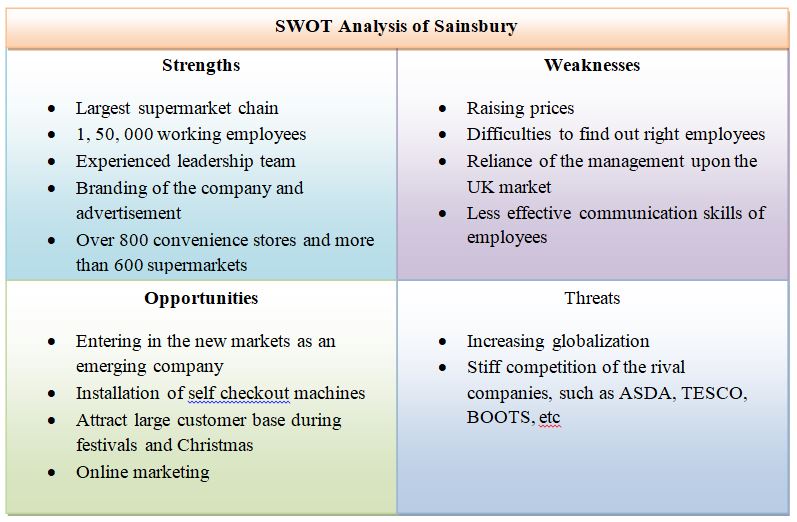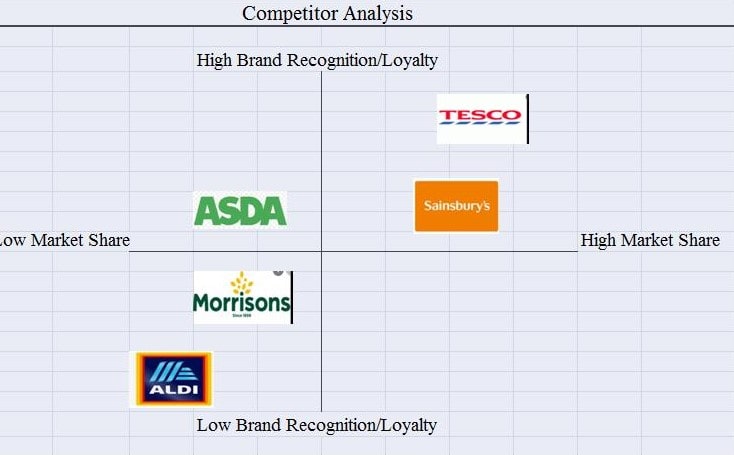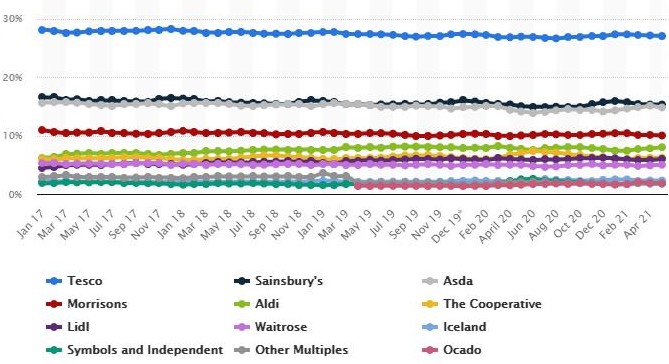SWOT Analysis and Competitor Analysis Of Sainsbury
Sep 24,21SWOT Analysis and Competitor Analysis Of Sainsbury
Question:
Discuss About The SWOT Analysis and Competitor Analysis of Sainsbury
Answer:
Introduction
In the competitive business environment, the analysis of a company is conducted to know its capability and market position. There are several methods used to conduct analysis of the company and identify both internal external capabilities and market position. In this report, SWOT analysis and competitor analysis of Sainsbury will be conducted in order to know its business capability and position in the market. A SWOT analysis is basically defined as a structured planning method that applied to evaluate the Strengths, Weaknesses, Opportunities and Threats of a company and its business. Further, in competitor analysis, the main competitors of the company in the market will be considered to compare in the market.
Company Background
Sainsbury is UK based Supermarket Company established in 1869 by John James Sainsbury in London beginning with a shop. In retail and lifestyle sector, Sainsbury has a leading food chain in the UK market that serves and help every customer through giving them delicious and great quality food with affordable prices. Sainsbury has over 600 supermarkets in the UK where customers shop and eat delicious foods to take benefits for their health and the environment (Sainsbury, 2021). Over 800 convenience stores of this organization can also be considered across UK that serves customers with giving delicious and great quality food at great prices.
SWOT Analysis of Sainsbury
Strengths:
The strengths of an organization are generally considered as the internal resources and capabilities that use in the business operations. The internal resources and capabilities provide a strong foundation to the organization that can be used to take competitive advantage and growth of the company in which an increasing sales of the products and a number of customer can be possible. In this scenario, the main strengths of Sainsbury can be identified as the largest supermarket chain of the company in the UK and over 1, 50, 000 working employees that serve people effectively and efficiently (Sainsbury, 2021). Further, the experienced leadership team, branding of the company and advertisement across the UK are also considered strengths of Sainsbury.
The strengths of the Sainsbury are also associated with holding over 800 convenience stores and more than 600 supermarkets that provide competitive advantage over its rivals in the UK. Apart from this, the information technology infrastructure and large capital investment of Sainsbury help to manage this company effectively. Further, the other strengths of the company that helps to increase sales and market share are the quality and delicious foods and loyal customers in the market. The use of recycled items and fewer plastics at its stores provide additional strengths to the company to make healthier and sustainable choices of the customers on the regular basis (Sainsbury, 2021). Moreover, the business strategy of the company can also be considered as a unique strength in order to support the business in the market as increasing market share and profits.
Weaknesses:
The weaknesses of a company also concerned with internal situation that is identified as the absence of certain strengths. Therefore, a weakness of Sainsbury can be seen as raising prices of the delicious foods because of rising foods prices at the global level. Further, it has difficulties to find out employees that have positive attitudes and skills to support in the business effectively. Moreover, weakness of the company is also associated with reliance of the management upon the UK market only where stiff competitive environment can reduce its market share and loyal customers (Fatricia, n.d.). The communication skills of the employees within the company are very less that also affect the businesses in the market as poor customer services.

Table 1: SWOT Analysis of Sainsbury
Opportunities:
Opportunity is related to the external environment of the organization that is identified as getting more profit and business growth chances in the market. Further, opportunity provides several benefits to the company, such as business expansion, increasing new customer base, and protection from ethical issues in the market. In this scenario, the opportunities of Sainsbury in the UK market in retail and lifestyle sector can be seen as entering in the new markets as an emerging company making joint ventures or partnerships in order to expand the business (Fatricia, n.d.). The growing economies in the global market are the Africa and Asia where Sainsbury can start this food chain Supermarket and stores effectively.
Apart from this, installation of self checkout machines will help the company providing services to customers for 24 hours that can also help to boost sales o foods and profits. The company has opportunity to attract large customer base during festivals and Christmas. The online marketing presence will be an effective marketing strategy of the company to increase awareness of the customers and increase sales through online orders (Fatricia, n.d.).
Threats:
Threats are associated with the external environment of company which has great impact on the business operations. When the changes in the external environment do not favor the business, it is identified as the threats for the company (Fatricia, n.d.). At this stage, the threats that Sainsbury may face in the market are increasing globalization and stiff competition of the rival companies, such as ASDA, TESCO, BOOTS, etc.
Competitor Analysis of Sainsbury
Perceptual Mapping Analysis:
The use of perceptual mapping or positioning mapping framework, the competitor analysis can be conducted effectively. Based on market share and brand recognition/loyalty of the competitors compared to Sainsbury Supermarket in the UK can be seen as below:

Market Share Analysis:
Competitor analysis is important to evaluate other companies’ position in the market. In the case of Sainsbury Supermarket, it has competitive environment in the UK market because of the presence of a large number of competitors, such as Asda, Tesco, Boots, Morrisons, Walmart, etc. The strategies of the rivals in the UK try to increase their market from its competitors. The largest market share of a competitor in retail sector is Tesco which lead Sainsbury over the years 2017 to May 2021. The Tesco has around 27% market share in this industry whereas Sainsbury holds around 15.3% in the UK (Coppola, 2021). Further, the market share of other competitors, such as ASDA and Morrisons are around 15.3% and 10.4% respectively.

Fig. 1: Market Share of Retail Companies in the UK
(Coppola, 2021)
Conclusion
After discussion of the SWOT analysis and competitor analysis of Sainsbury, it can be stated that the company can take competitive leads in the UK market because of its high quality products provided to the customers. The SWOT analysis and competitor analysis of the company explore its capabilities to expand the business in new market at the global level.
References
Coppola, D. (2021). Grocery market share in Great Britain 2017-2021. Retrieved from: https://www.statista.com/statistics/280208/grocery-market-share-in-the-united-kingdom-uk/
Fatricia, R. S. (n.d.). SWOT ANALYSIS OF SAINSBURY’S SUPERMARKET. Retrieved from: https://core.ac.uk/reader/229104600
Sainsbury. (2021). Our business strategy. Retrieved from: https://www.about.sainsburys.co.uk/about-us/our-business-strategy





